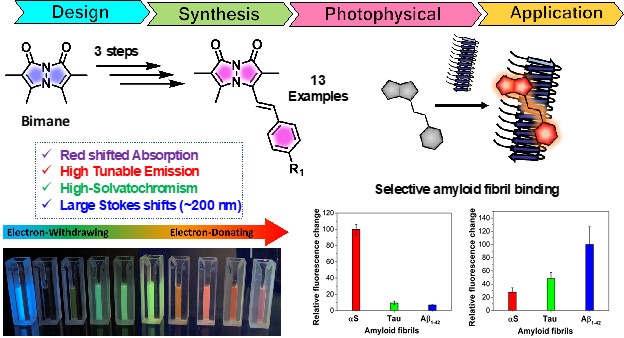Bimane-based fluorescent probes with turn-on fluorescence in the presence of α-synuclein, a known hallmark of Altzeimer’s and Parkinson’s diseases.
Problem:
Small fluorogenic probes with high sensitivity and selectivity are powerful tools for studying the accumulation of amyloid fibrils in cells or tissue samples from patients with Alzheimer's disease (AD), Parkinson's disease (PD), and many neurodegenerative disorders. Thioflavin-T (ThT) is a widely used dye for staining amyloid fibrils because its binding to amyloid fibrils increases its fluorescence intensity. However, ThT has a relatively small Stokes shift (50 nm), which is problematic when combined with other spectrally similar molecules. It also has poor selectivity for fibrils over other aggregates, and poor cellular uptake.
Solution:
Bimane-based fluorescent probes that exhibit turn-on fluorescence in the presence of AD/PD biomarkers with good cellular uptake and without binding to other fibrils, allowing for early, facile, rapid detection of AD/PD and other neurodegenerative diseases.
Technology:
A synthetic route that enables rapid access to fluorescent probes from bimane chromophores, which show good fluorescent turn-on and selectivity among fibril types. The current probes can detect amplified fibrils (AFs) from patient tissues, while the previous method, ThT, cannot detect them effectively. In addition, the probes have large Stokes shifts in the presence of pre-formed fibrils (PFFs) and low background fluorescence in cell lysate, making them a potential PD/AD biomarker.
Advantages:
- Simple synthetic route allows for easy and potentially scalable synthesis
- Large stokes shifts (approx. 200 nm) compare favorably to current dyes used in this approach (approx. 50 nm), giving better signal to noise signals
- The selectivity of these probes is favorable compared to other typical probes, which suffer from lack of selectivity in fibril identity as well as poor cellular uptake

Synthesis of bimane fluorescent probes with tunable emission for the detection of α-synuclein, a known hallmark of Altzeimer’s and Parkinson’s diseases.
Stage of Development:
- Proof of Concept
- Bench Prototype
Case ID:
23-10337-TpNCS
Web Published:
6/27/2024
Patent Information:
| App Type |
Country |
Serial No. |
Patent No. |
File Date |
Issued Date |
Expire Date |